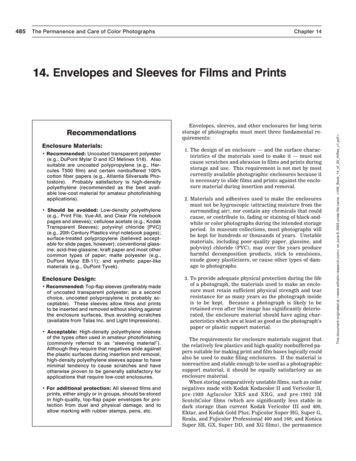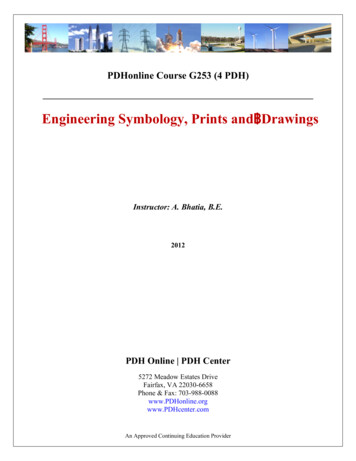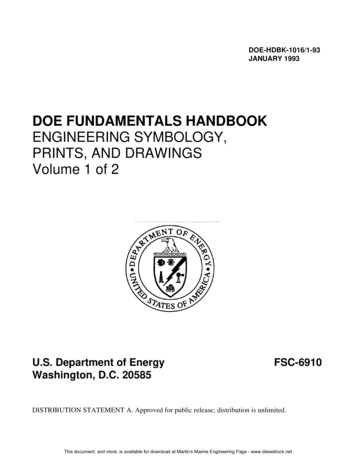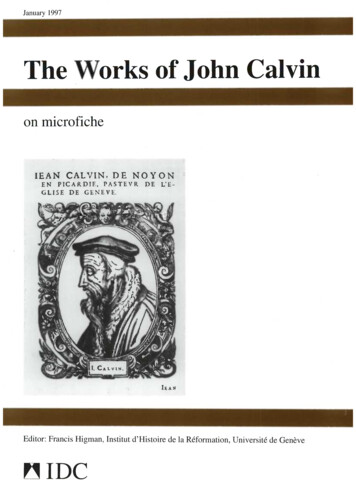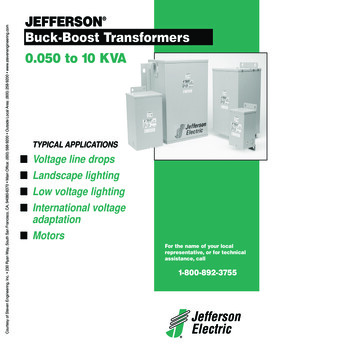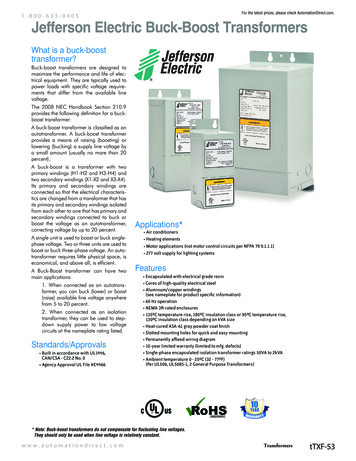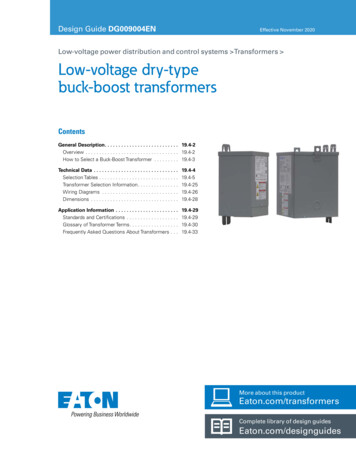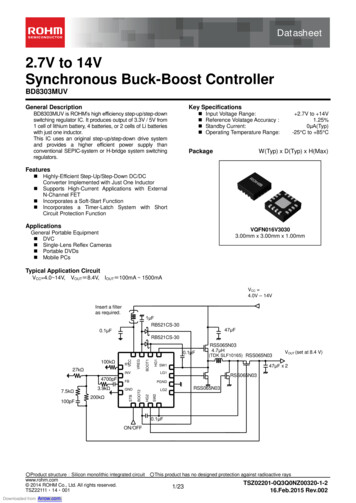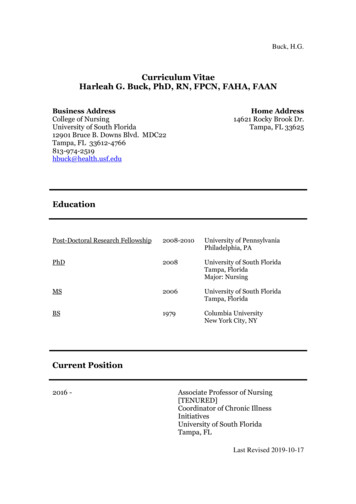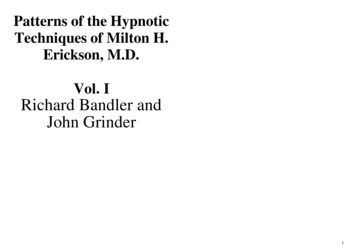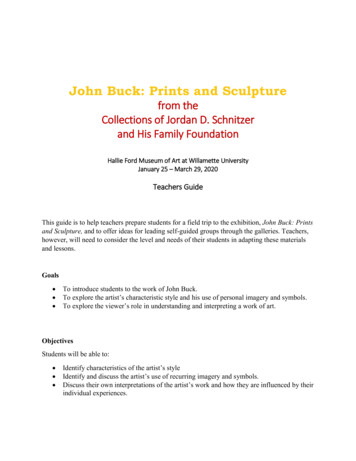
Transcription
John Buck: Prints and Sculpturefrom theCollections of Jordan D. Schnitzerand His Family FoundationHallie Ford Museum of Art at Willamette UniversityJanuary 25 – March 29, 2020Teachers GuideThis guide is to help teachers prepare students for a field trip to the exhibition, John Buck: Printsand Sculpture, and to offer ideas for leading self-guided groups through the galleries. Teachers,however, will need to consider the level and needs of their students in adapting these materialsand lessons.Goals To introduce students to the work of John Buck.To explore the artist’s characteristic style and his use of personal imagery and symbols.To explore the viewer’s role in understanding and interpreting a work of art.ObjectivesStudents will be able to: Identify characteristics of the artist’s styleIdentify and discuss the artist’s use of recurring imagery and symbols.Discuss their own interpretations of the artist’s work and how they are influenced by theirindividual experiences.
INDEXINTRODUCTION by John Olbrantz 3BEFORE THE MUSEUM VISIT .4Looking at the Work of John Buck: Argosy and Taj Mahal .4AT THE MUSEUM . 10RESOURCES AND REFERENCES 11COMMON CURRICULUM GOALS . 11IMAGES .122
INTRODUCTIONJohn OlbrantzThe Maribeth Collins Director, Hallie Ford Museum of ArtJohn Buck (American, born 1946) is a nationally recognized Montana artist who has created alarge and powerful body of woodcut prints and wood sculpture over the past four decades. Bornin Ames, Iowa, in 1946, Buck knew early on that he wanted to be an artist. His father hadaspirations to be an artist as well but was forced to put those dreams aside, and instead supportedhis family as a construction worker. His son was luckier.Buck earned his BFA degree at the Kansas City Art Institute in 1968 where he learned the basicsof sculpture, working primarily in welded steel and bronze casting, and completed his MFAdegree at the University of California, Davis in 1972, where he studied with the artists RobertArneson, Roy DeForest, Manuel Neri, and William T. Wiley. It was at Davis that he met hiswife, the artist Deborah Butterfield.In 1976, Buck moved to Bozeman, Montana, where he accepted a teaching position at MontanaState University. Because he no longer had access to the expensive equipment required forwelding and casting that he had found at Davis, he turned to wood carving and, in time, towoodcut prints. A virtuoso draftsman and imaginative sculptor, Buck explores a wide range ofnational and global issues in sophisticated works that are imbued with complex iconography andoften layered with multiple meanings.Over the years, Buck has become fascinated with the cultural imagery surrounding his homes inMontana and Hawaii, where he and Butterfield reside for half the year, as well as with currentevents, popular culture, and the irony and humor found in world history. His large-scale woodcutprints are deliberately couched in the language of popular art, recalling graffiti art, cartoons,posters, and political broadsides.Buck’s approach to printmaking is unique. Starting with a large block of wood, he carefullycarves the central image with a variety of sharp tools. Next, the images in the background areincised into the wood using a sharp object like a nail, hard pencil, or ballpoint pen. When theimage is complete, he cuts the block apart in sections that can be reassembled like a large jigsawpuzzle. The individual parts can be inked in various colors and once reassembled, can be printedat one time.Because the background lines are so shallow Buck prints the key blocks by hand-burnishingrather than using a press, which would slowly crush the wood as well as flatten out the smallerlines. His burnishing tools range from metal spoons and drawer-pulls to knobs of various sizeand shapes to objects like folding bones. The process is very labor intensive but allows Buck towork on a scale that is unprecedented in the history of printmaking.Similarly, his wood sculptures draw on popular sources—especially the simplified forms ofcountry woodcarvers—but there are echoes of modernist sculptors like Constantin Brancusi,3
Alberto Giacometti, Joan Miró, and Pablo Picasso in much of his sculptural work. Moreover, hisfreestanding sculptures are less overtly narrative than his prints, and instead offer assortments ofsymbolic objects balanced upon the headless bodies of male or female figures, or held in theirhands.Throughout his long and distinguished career, Buck has been featured in dozens of solo andgroup exhibitions throughout the United States, and his work can be found in numerous publicand private collections throughout the region and nation, including the Hallie Ford Museum ofArt. The legendary print collections of Jordan D. Schnitzer and His Family Foundation areparticularly rich and deep in their holdings of John Buck’s prints.John Buck: Prints and Sculpture from the Collections of Jordan D. Schnitzer and His FamilyFoundation has been supported by Jordan D. Schnitzer and His Family Foundation and bygeneral operating support grants from the City of Salem’s Transient Occupancy Tax funds andthe Oregon Arts Commission.4
BEFORE THE MUSEUM VISIT If possible, visit the exhibition on your own beforehand.Use the images and suggested discussion below to introduce students to the work of JohnBuck.Make sure students are aware of gallery etiquetteLooking at the Work of John Buck: Argosy and Taj Mahal“My work focuses on three basic formats: woodblock prints, wood relief panels, and [wood]sculpture, which feed into one another. By shifting from printmaking to sculpture . . . I am ableto see with a fresh eye.”— John BuckJohn Buck is a collector of images – natural and man-made objects that are part of his everincreasing visual vocabulary. These images are recurring in his work, over a variety of media.Their meaning, however, is rather fluid: sometimes a single image can take on different roles indifferent works, and while it may bring with it universal associations, its interpretation ultimatelylies with the viewer. As writer and curator Linda Tesner says about Buck’s imagery:While Buck’s work is highly representational, his vocabulary of imagery is not meant tobe specific . [He] is willing to concede that many elements of his work speak to auniversal understanding – his frequent use of the world globe, for instance – [yet] he isreticent to share too much of what his imagery means personally, let alone what it“should” mean to the viewer. He cautions that no matter what the art form, eachindividual confronts a work of art with visual references built on his own or her ownexperiences, memories, and emotions. 1John Buck’s prints are full of imagery reflecting current events, political issues, the humancondition, ideas about place, and the artist’s personal history. The background is filled withfigures and objects – either as part of little vignettes or scenes or by themselves in a moresymbolic way – that are incised into the surface of the block. These images are in conversationwith the large, often multi-colored central form: together they create a deeper or morecomplicated reading of the print, and while together they, and perhaps the title, can influenceinterpretation, a literal reading eludes the viewer.Buck’s wall reliefs (as well as the freestanding sculpture featured in the exhibition) are lessnarrative than the prints, and rely more on association than storytelling. The reliefs consist ofindividual wooden niches with a visual symbol set inside. Some are carved, some are panels thatare painted, drawn, and/or incised. These elements are arranged to encourage visual orconceptual connections. Many of the same figures or symbols from the prints are found in thereliefs (and freestanding sculptures), but their meanings and relationships are more ambiguous,even mysterious.Tesner, Linda, “John Buck: Storyteller of the Human Experience,” p. 7, John Buck: Recent Sculpture andWoodblock Prints15
Argosy1998Edition 10/15Eight color woodcutSheet: 62 1/2 x 37 inchesFramed: 65 1/8 x 39 3/8 inchesCollection of the Jordan Schnitzer Family Foundation, 1999.32 2019 John Buck / Licensed by VAGA at Artists Rights Society (ARS),NY. Photo: Strode Photographic LLC.About the WorkThe glass jar, which is the central figure in the print, Argosy, is a recurring image in John Buck’swork, both carved and printed, but also as sculptures actually fabricated in glass. These largeglass jars were created during residencies at Pilchuck Glass School in Stanwood, Washington.When Buck and his wife, the sculptor Deborah Butterfield first arrived at their bungalow theydiscovered a forgotten potato growing a profusion of foliage on the kitchen table. This led Buckto direct the resident gaffer to fabricate glass jars, which he initially used to create a glasssculpture of a blown jar and a lampworked sprouting potato, titled Idaho Potato Jar (1997). Hethen followed with Argosy, as well as several other prints and sculptures featuring the glass jar.Like much of Buck’s work, Argosy explores the contradictory qualities of familiar symbols, andthe conflict between our ideals and reality. The title refers to Argus, the hundred-eyed creaturefrom Greek mythology who was all-seeing (the term “Argus-eyed” means to be keenlyobservant). Here, the many eyes of the potato suspended in the jar observe the human folly, andtragedy, represented in the background images. These include: A blindfolded Mickey Mouse evoking the symbol of blind Justice, holding a bag ofmoney. A Bambi-like pulling a cart filled with emblems of American power, among them theCapitol Building and the Washington Monument. The Statue of Liberty rising from a shopping cart pushed by the shrouded figure of death. Other characters include a skeleton on a pogo stick and several homeless people, one ofwhom dabs at an artist’s palette with a paintbrush. What else can you find?6
Suggested Discussion (Always begin with aesthetic scanning before sharing the title or otherinformation about the work)Aesthetic Scanning: What do you see here? Describe what you see in the work. Where does your eye go first? Where does itgo next? Why? How has the artist used the elements of art (lines, color, shape, form, texture,space, etc.) and the principles of art (the way it is organized, i.e., pattern, contrast,balance, proportion, unity, rhythm, variety, emphasis)? What do you think is happening in this work? What objects or symbols has the artist included? Do they relate to each other?Explain Are there stories, and do they relate to each other and the central image? Is there atheme? Explain What do you think the objects could mean? What are your own associations withthe object(s) or figure(s)? Are they personal? Cultural or historical? Do yourown associations influence your interpretation of the object(s)? Of the meaning ofthe work as a whole? Explain. What do you think the artist is trying to say?Share with students the title and information about the work. What, if anything does this add to your own interpretation of the work? Did your initialinterpretation change at all with this information? Explain.7
Taj Mahal2003Jelutong wood with acrylic48 x 48 x 2 3/4Collection of Jordan D. Schnitzer, 2005.162 2019 John Buck / Licensed by VAGA at Artists Rights Society (ARS),NY. Photo: Strode Photographic LLC.About the WorkIn Taj Mahal, we once again see the image of the sprouting potato in the glass jar, but how itrelates to the other images in the composition is more elusive than how it relates with the otherelements in Argosy; the relationships are more associative than narrative. As Linda Tesner notes,the artist’s intention was to make the wall panels deliberately nonnarrative and nonlinear, andthat “[t]hey are more appropriately viewed in the spirit of surrealism or dream content.” 2Along with the image of the sprouted potato in the jar, Buck has included:2 The Taj Mahal The Guggenheim Museum in New York City A map of lower Manhattan, New York City Two world globes, one with the USA featured prominently. A beard A hand holding a stick beneath a wasps nest Two forms; one solid and geometric, the other sinuous and amoeba-likeTesner, Linda, “The Mechanical Nature of John Buck,” p. 31, John Buck8
Suggested Discussion (Always begin with aesthetic scanning before sharing the title or otherinformation about the work)Aesthetic Scanning: What do you see here? Describe what you see in the work. Where does your eye go first? Where does itgo next? Why? How has the artist used the elements of art (lines, color, shape, form, texture,space, etc.) and the principles of art (the way it is organized, i.e., pattern, contrast,balance, proportion, unity, rhythm, variety, emphasis)? How do the individual elements relate to each other visually? What do you think is happening in this work? What objects or symbols has the artist included? Do the objects relate to each other conceptually as well as visually? Is the artisttrying to tell a story? Create associations or feelings? Explain What are your own associations with the object(s) or figure(s)? Are theypersonal? Cultural or historical? Do your own associations influence yourinterpretation of the objects? Of the meaning of the work as a whole? Explain. What do you think the artist is trying to say?Share with students the title and information about the work. What, if anything does this add to your own interpretation of the work? Did your initialinterpretation change at all with this information? Is it important to know the artist’s meaning or intent in creating a work, or do you think itshould be left up to the viewer? ExplainCompare and Contrast How are Argosy and Taj Mahal similar? How are they different? Think about how you responded to each work. How and why were your responses toArgosy and Taj Mahal similar? How and why were they different?9
AT THE MUSEUM Review with students what is expected – their task and museum behavior.Be selective – don’t try to look at or talk about everything in the exhibition.Focus on the works of art. Encourage students to look closely at individual works of artand consider the same discussion strategies they used in the classroom. Breaking intosmall groups works well for this.Before looking at the title or label information, spend time with the work using AestheticScanning.Aesthetic Scanning: What do you see here? Describe what you see in the work. How has the artist used the elements of art (lines, color, shape, form, texture,space, etc.) and the principles of art (the way it is organized, i.e., pattern, contrast,balance, proportion, unity, rhythm, variety, emphasis)?oWhere does your eye go first? Why? How does your eye move around the painting? Is it led by color? By line? Byshape? By pattern? By size?oHow has the artist created compositional unity and balance?oHow do the individual elements relate to each other visually? What do you think is happening in this work? What objects or symbols has the artist included? Do the objects relate to each other conceptually or visually? Is the artist trying totell a story? Create associations or feelings? Explain What are your own associations with the object(s) or figure(s)? Are theypersonal? Cultural or historical? Do your own associations influence yourinterpretation of the object(s)? Of the meaning of the work as a whole? Explain. What do you think the artist is trying to say?Read the title and any information included in the label. What do you think the artist is trying to say? What, if anything does this add to your own interpretation of the work? Did your initialinterpretation change at all with this information?Compare and Contrast Look for prints, free-standing sculpture, and reliefs that share the same imagery – afigure, shape, or symbol. How does the way the artist uses this element (its visualimpact, its meaning, its relation to other figures and forms) change from one work toanother, and from one medium to another? Do you see it as part of a linear narrative (astory or vignette); creating an association; a visual element? Explain. Think about how you responded to each work. How and why were your responsessimilar? How and why were they different?10
RESOURCESTesner, Linda, John Buck: Recent Sculpture and Woodblock Prints. Lewis & Clark College,Portland, Oregon, 1999.Tesner, Linda, et. al., John Buck. Marquand Books, Inc., Seattle, 2014.OREGON STATE CONTENT STANDARDS: Grades 4-HSVisual ArtsAnchor Standard 7: Responding—Perceive and analyze artistic RE1.8VA.7.REI.HS1-2Anchor Standard 8: Responding—Interpret intent and meaning in artistic RE2.8VA.1.RE2.HS1-2Anchor Standard 10: Connecting—Relate artistic ideas and works with societal, cultural, andhistorical context to deepen understanding.VA.10.CO1.HS1-311
12
Argosy (detail)13
Argosy (detail)14
Argosy (detail)15
16
State University. Because he no longer had access to the expensive equipment required for . The individual parts can be inked in various colors and once reassembled, can be printed at one time. . Argosy, is a recurring image in John Buck’s work, both carved and printed, but als
